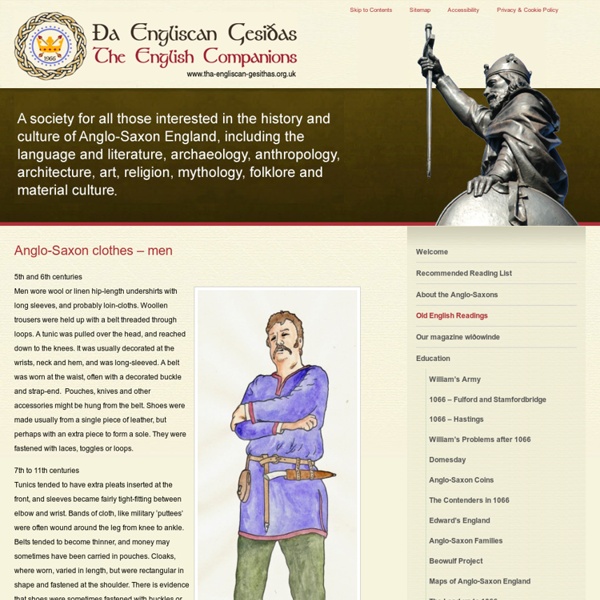Anglo-Saxon clothes - women | Tha Engliscan Gesithas
5th to 7th centuries Women wore an under-dress of linen or wool with long sleeves and a draw-string neck. Sleeves were fastened with clasps for wealthier women, or drawn together with braid or string for poorer women. The outer dress was a tube of material, rather like a pinafore, and often called a ‘peplos’. A pair of shoulder-brooches or clasps held this onto the under-dress. 7th to 9th centuries Shoulder-brooches and wrist-clasps went out of fashion, and the sleeves of the over-dress now came to just below elbow-length on the arms and calf-length around the legs. 10th to 11th centuries The under-dress was now often pleated or folded, while the sleeves of the over-dress tended to flare towards the wrist. Children seem to have worn very much the same style of clothing as adults, but in smaller sizes. Making clothes was women’s work, and spinning and weaving were among the main activities of women in the Anglo-Saxon period.
Anglo-Saxon Instruments - English Historical Fiction ...
by Richard Denning We have a pretty good idea of what musical instruments the Anglo-Saxons used. The Cotton collection in the British Museum includes the top image showing a Saxon king playing a harp with a horn player, an early trumpet and a rebec (a early violin type instrument). The lower image shows a lyre, bone flute and another type of woodwind. I now own four replica instruments based on Anglo-Saxon originals so I thought I would show them today. First I have the Horn. Next up is the bone flute. Drums were certainly used. Finally here is my lyre. This is the original Sutton Hoo Lyre in the British Museum: Here is a video of me playing (badly) these instruments. --------------------------------------------------------------- Richard Denning is an author of historical fiction.
Primary History - Anglo-Saxons - Anglo-Saxon beliefs
Concepts of Authenticity in Early Music and Popular Music Communities | Ethnomusicology Review
22 Christopher Page published his research in a series of articles and books, beginning with “Machaut’s ‘Pupil’ Deschamps on the Performance of Music.” Early Music, 5 (1977), 484–91, and “The Performance of Songs in Late Medieval France: A New Source,” Early Music 10 (1982), 441-450. On Page and Gothic Voices and their reception in Early Music and musicological circles, see Leech-Wilkinson, The Modern Invention of Medieval Music (2002), chapter 2. 23 An interview with Renée Fleming, published in late 2003, was quoted online in January 2004: “I am the voice of Gollum - just before he dies. He's my favorite. Appendix: some (mostly British) musicians, listed in order of birth 1920s Joan Sutherland, (b Sydney, 7 Nov 1926; d near Montreux, Switzerland, 10 Oct 2010), soprano Gustav Leonhardt, (b ‘s Graveland, 30 May 1928; d Amsterdam, 16 Jan 2012), harpsichord, organ, conductor Andrea Von Ramm, (b Pärnu, Estonia, 8 Sept 1928; d Munich, 30 Nov 1999), soprano 1930s David James (b 1950), countertenor
Ashmolean Museum: Anglo-Saxon Discovery - Beliefs
When did the Anglo-Saxons become christians? When the Romans left, just after AD400, there were still some christians in Britain, but when the Anglo-Saxons arrived most people appear to have become pagans. Archaeologists can tell this from the types of burials, since pagans buried people with their possessions but christians did not. The christian church in Rome sent a monk called Augustine to England in AD597 to convert the Anglo-Saxons to christianity. At the same time, in the north of Britiain, christian monks arrived from Ireland and converted the Picts in Scotland and the Anglo-Saxons in Northumbria. Graduallly more and more Anglo-Saxons became christians until christianity replaced paganism altogether. The christians built churches and founded monasteries all over the country. Are there any Anglo-Saxon churches where you live? Find out more about Anglo-Saxon churches
Life in Anglo-Saxon England
1. Introduction The Anglo-Saxon period lasted for some six centuries, from the arrival of Germanic invaders from the continent during the early fifth century AD to the Norman Conquest of 1066. This was a time of immense political and social upheaval which saw major changes in almost all aspects of everyday life. The early pagan settlers lived mainly by farming (see Unit 9, Farming), and formed a number of separate — and warring — kingdoms. By around 700 AD, there appears to have been a ‘Heptarchy’ of seven kingdoms (Northumbria, Mercia, East Anglia, Wessex, Essex, Sussex and Kent), while the main four in the ninth century were Northumbria, Mercia, East Anglia and Wessex. 2. Anglo-Saxon kings were prolific legislators, and a number of law-codes survive from the seventh to eleventh centuries. 3. 4. A substantial literature survives from Anglo-Saxon England in both Latin and Old English. Other original writings in Old English include sermons, saints’ lives and wills. 5. 6. 7. Websites
Primary History - Anglo-Saxons - Kings and laws
Primary History - Anglo-Saxons - Anglo-Saxon life
Primary History - Anglo-Saxons - Anglo-Saxons at war



